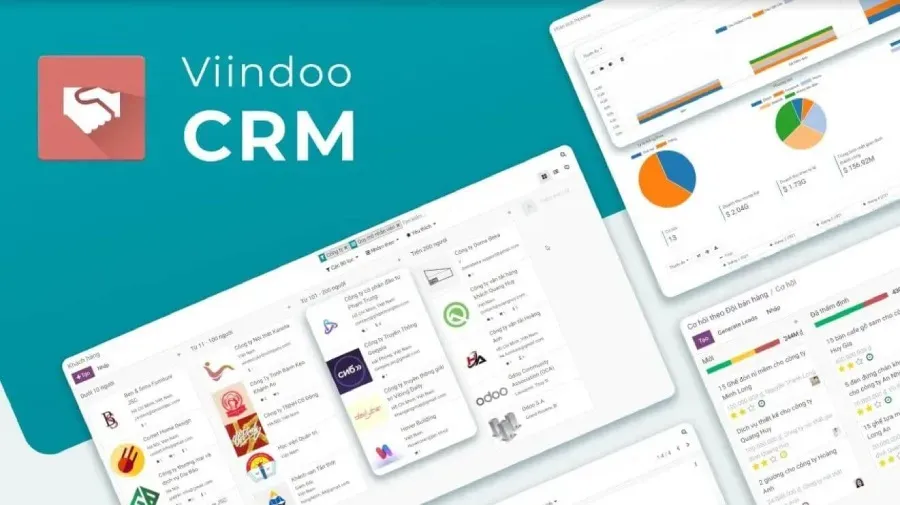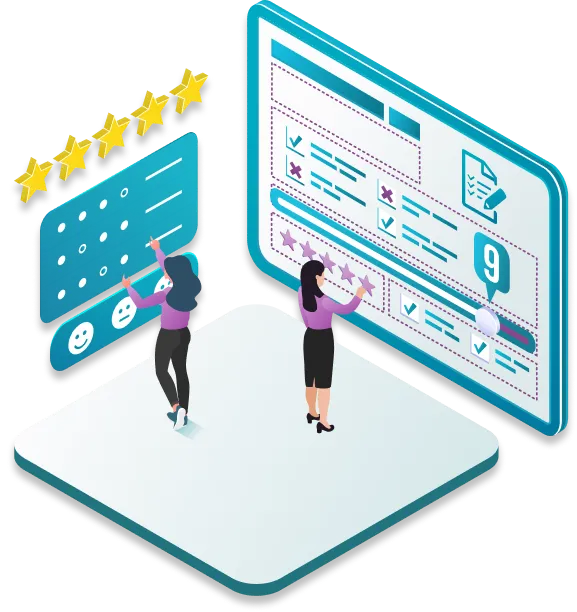Nowadays, many enterprises have chosen to build a business strategy based on the “Net Promoter Score” principle.
“The greatest asset of all companies is its customers because without customers there is no company,” Dr. Michael Leboeuf, the world's leading business speaker, once affirmed. Customers are always an essential factor to boost profits and elevate the brand. However, not all businesses understand this properly. In this article, Viindoo shares with you the golden secrets to help enterprises to build a successful “customer centric” strategy.
What is a customer centric business strategy?
Customer centric is based on tracking customer experience trends as the core operation of your business. This strategy focuses on customers to research and develop products and services. The purpose of customer centric is to create satisfaction for consumers in the process of purchasing and using products.
An effective customer centric strategy also helps retain customers, make the most of the existing customer demographic, increase repeat customers, and improve reputation as well as business profit.

What is customer-centric?
>>>> Read More: Customer care software
The importance of a customer centric business strategy
No business can climb to the top without being aware of how important its customers are. Deloitte Touche’s research shows that customer-oriented businesses are 60% more profitable than those without a customer-centric strategy.
This number confirms the significance of a customer centric strategy compared to conventional business strategies, especially in today’s increasingly competitive economy.
Even if this strategy requires businesses to exert, invest, and research more to deliver positive customer experiences. Its benefits are not just a good impression, attracting and retaining customers, or boosting profit. It also helps businesses elevate brand value and expand their market share.
A well-developed customer-centric strategy is a sustainable competitive advantage and a stepping stone for an enterprise to surpass competitors.

A customer-centric strategy helps businesses achieve customer satisfaction.
>>>> See More: Customer relationship management strategy
Secrets to building a "Customer-centric" strategy
A customer-centric business strategy brings many benefits to businesses. However, successfully constructing it remains a challenging problem for managers. Besides, to meet customer needs, businesses need to actively improve the customer experience with the following 3 tips:
Employee training
Employees are the people working directly with consumers and customers. Therefore, in order for employees to understand business strategy, the company needs to focus on training courses. Through these training sessions, employees will be supplemented with knowledge about business strategy and understood the role of customer-centric strategy.

Training sessions will help employees acquire professional knowledge
Effective interaction with customers
The way companies approach and interact with customers plays a decisive role in the success—or failure—of building a customer-centric strategy. The questions are:
- What does “effective customer interaction” mean?
- Is the customer interaction frequency at a moderate level?
- Is the business annoying prospective customers? How about forgetting them?
All of these questions are issues that companies must address when building a customer-centric strategy.
To interact well with customers, enterprises should build appropriate tactics. The earliest possible interaction opens up more opportunities for a company to introduce more products and services to customers.
Imagine, as soon as the customers have a touchpoint with the company, you provide a prompt response while they are still there and can receive information. This is the perfect moment for customers to make a purchase decision. If it takes too long for you to respond, customers will have more time to choose while comparing with your competitors, which worsens your sales opportunities.

Companies should prioritize customer-centric
Besides, prospects can be everywhere, so interacting with customers as much as possible on different communication channels is also advisable to pull customers closer to your business.
You should also apply omnichannel marketing such as email, messages, websites, social media sites, and so on—to keep in touch with customers who have bought your goods or services, to promote your brand, and to cultivate prospects. This is definitely the most natural and effective method of increasing sales.
One of the more effective ways to increase customer interaction is to use software that supports you in approaching, taking care of, and managing customers.
The use of Live Chat to promptly interacts with visitors while they are still browsing your websites can foster a superb experience for customers.
If customers’ concerns are always heard and answered without delay, customers will gain an affinity for the business, increasing their purchasing probability.

Online Chat app interface of Viindoo Solution
Currently, many enterprises have realized the importance of Viindoo CRM Software - Customer Relationship Management and invested in them to support customer services and management. The biggest advantage of CRM software is the classification of customers into groups and the ability to construct a customer profile (basic information, purchasing ability, response time, and so on).
CRM software also optimizes the customer care plan with a system of automatic reminders covering all tasks. As a result, companies can adjust interaction frequency and easily trace customer service history—to avoid spam or unfortunate neglect of customers.

CRM software interface of Viindoo Solution
In addition, CRM software also helps managers determine what sources their customers come from and how cost-effective such sources are, to make proper decisions about resource and budget allocation.
Discover Viindoo CRM Software
The All-in-one CRM Software for SMEs. Effectively manage their sales pipeline, track customer interactions, and nurture relationships to drive growth and revenue.

Collection of customer feedback
As Jerry Gregoire—founder and president of Redbird Flight Simulation—puts it, “We have entered the era of the customers. Today, delivering superior customer services is essential to loyal customers and a lasting brand.” How can we deliver superior customer service?
The key here is to use customer feedback to consider and adjust the strategy accordingly. Instead of just relying on assumptions, businesses should learn and draw lessons from users in the following ways:
- Build online survey questionnaires and publish them on media channels to collect genuine information about business performance.
- Use an email marketing campaign to collect customer feedback on their experience with your goods or services.
- The results of customer surveys and reviews are the basis for managers to come up with effective strategies, improve team quality, and retain customers.
The results of customer surveys and reviews are the basis for managers to plan effective product strategies, improve team quality, and retain customers.

Viindoo Survey interface: Viindoo’s survey app helps businesses build quality customer surveys.
Discover Viindoo Survey
- Conduct surveys on any topic for any audience
- Automate the survey creation and data processing, visualization
- Collect real-time feedback to enhance decision-making

Cultivation of customer loyalty
If a customer is treated like a valued house guest rather than just “some buyer”, they will feel more engaged and more inclined to continue supporting the business.
Making customers feel like they are experiencing products and services in a more special way than others help businesses expand their loyal customer base and increase revenue from them.
A Loyalty Program is one of the best ways to cultivate customer loyalty. In addition to giving bonus points and rewards (like gifts or discounts) with every purchase, companies can classify customers into rankings (bronze, silver, gold, and higher) and apply different pricing to expand and develop the loyalty program.

The Rewards Statistics interface of the Loyalty Customer app in Viindoo Solution.
Furthermore, remembering their buying habits or special occasions is also a plus point for your company in the eyes of customers. All such customer information must be saved in the corresponding customer profile on the software so that the employees can search and retrieve it, optimizing and personalizing the customer experience.
In addition, for each customer’s birthday, automatic birthday emails are also a popular way to remind them of the company while saving time and human resources, which contributes to an optimized customer-centric strategy.
Viindoo Loyalty Program Software
Nurture relationships with customers to enhanced engagement and retention strategies, drive growth and revenue.

Customer experience measurement
Measuring customer experience when they shop or buy products & services will help businesses determine whether their current business strategy is meeting the needs of consumers or not. As a result, the company will take timely corrective measures.

Companies need to regularly measure customer experience
To measure consumer experience, businesses can use the Net Promoter Score (NPS). This is a popular formula used by many companies. This index regularly measures and updates consumer opinion. In addition, NPS can also create a list of employees who are rewarded or punished. As a result, employees will be more dedicated to their work.
Customer-centric strategic metrics
Determining the level of customer experience is not easy. Effective metrics will help brands solve the above problem. So, what is customer-centric strategy's applied metric? To get the most complete answer, readers can learn the following information.
Customer churn rate
Customer churn rate (CCR) is the ratio between the number of customers leaving and existing customers at a given time. The formula for calculating CCR is the total number of consumers leaving divided by the total number of consumers in each month, quarter, or year.

Brand abandonment rate is one of the strategic metrics.
Customer satisfaction
Customer satisfaction is one of the most complex metrics to measure. Therefore, to evaluate the experience of consumers, businesses can rely on the ladder-specific number. Many brands have put questions under the survey such as "How satisfied are customers when using the company's products or services?".

Customer satisfaction indicates the level of customer satisfaction
After that, the business will give a scale from 1 to 5. Each number will be based on a different level such as "Very Dissatisfied - Unsatisfied - Neutral - Satisfied - Very Satisfied". When businesses use this scale, the measurement of emotional factors will become most obvious.
Customer lifetime value
Customer Lifetime Value is understood as the value that consumers have brought to the brand in the lifetime of the experience. This index will be calculated from the time a customer makes a purchase or uses a service for the first time until all transactions stop.

The long-term value of customers is understood as the value that customers have brought to the company
When a business owns a customer-centric strategy The most valuable asset is the number of customers that the company has attracted. Therefore, customers who own long-term value will bring abundant profits to the business.
Satisfaction and product recommendation - Net Promoter Score
Satisfaction level and product recommend ability (NPS) are also two important indicators that need to be considered. Through this index, businesses will know if their products are recommended by customers to their relatives, colleagues, or friends. From there, the company can propose appropriate policies and measures to improve customer satisfaction and the ability to recommend products and services.
To understand the level of satisfaction and product recommendation (Net Promoter Score), businesses need to survey customers. This measurement method is divided into 3 groups on a 10-point scale as follows:
- Detractor: This group of people will be worth a score of 0-6 points. This is the percentage of unsatisfied consumers. When businesses, unfortunately, have this ratio, they may lose customers. At the same time, the business has left a bad look in the eyes of colleagues, and relatives of customers. Thereby, the number of new customers will be greatly reduced.
- Passive people: This group of people often uses a scale of 7 to 8 points. These are customers in a neutral and rather indifferent state. This group of consumers may continue to recommend the brand's products to friends or switch to another brand's product.
- Promoters: The group of loyal and brand-loving consumers will be on a scale of 9 to 10. This is reflected in the fact that customers will recommend the company's products to their relatives and colleagues. Thereby, the number of new customers will increase.
For example, A business conducted a survey with a scale of 100 customers and gave the following results:
50 Promoters for a 50% chance, 25 passives for a 25% chance, and finally 25 detractors for a 25% chance. From there, the level of satisfaction and product recommendation will be 25% (50% - 25% = 25%).

NPS is a measure that helps businesses assess customer satisfaction
Discover Viindoo CRM Software
The All-in-one CRM Software for SMEs. Effectively manage their sales pipeline, track customer interactions, and nurture relationships to drive growth and revenue.

Above are the three secrets to building a customer-centric strategy. Hopefully, Viindoo 's article helps businesses easily build a customer-centric strategy more comprehensively and efficiently.